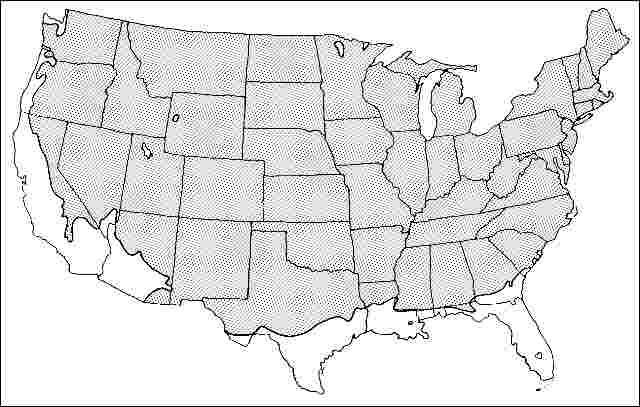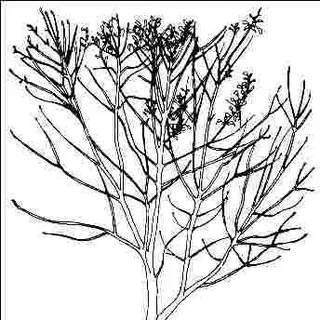Fraxinus pennsylvanica 'Newport': 'Newport' Green Ash
Introduction
‘Newport' green ash (also known as Baileys Select) grows into an upright pyramidal form when young, maturing to a rather open, oval silhouette 55 feet tall by 40 feet wide. Once developed properly in the nursery, the trunk remains straight up through the crown of the tree and the branch habit is reported to be better than the species. Early pruning helps assure that this happens. The trees grow quickly and can sometimes reach 80 feet in height. Green to reddish-purple flowers appear in spring but do not produce fruit since the plant is a male. This could make this a superior replacement for the once very popular ‘Marshall Seedless' which has some female trees mixed with the population, and now some trees are fruiting. ‘Marshall Seedless' is also reportedly susceptible to storm damage, although some of this could be due to improper or no pruning. Unlike other green ashes which have unpredictable fall color, ‘Newport' green ash displays foliage of an intense golden-yellow. The attractive bark is red-tinged and furrowed.

Credit: UF/IFAS
General Information
Scientific name: Fraxinus pennsylvanica
Pronunciation: FRACK-sih-nus pen-sill-VAN-ih-kuh
Common name(s): 'Newport' Green Ash
Family: Oleaceae
USDA hardiness zones: 3A through 8A (Figure 2)
Origin: native to North America
Invasive potential: native cultivar
Uses: reclamation; urban tolerant; shade; street without sidewalk; parking lot island > 200 sq ft; sidewalk cutout (tree pit); tree lawn > 6 ft wide; highway median

Credit: UF/IFAS
Description
Height: 55 to 60 feet
Spread: 40 to 50 feet
Crown uniformity: symmetrical
Crown shape: upright/erect, oval
Crown density: moderate
Growth rate: fast
Texture: medium
Foliage
Leaf arrangement: opposite/subopposite (Figure 3)
Leaf type: odd-pinnately compound
Leaf margin: crenate, serrate, entire
Leaf shape: ovate, lanceolate
Leaf venation: pinnate
Leaf type and persistence: deciduous
Leaf blade length: 2 to 4 inches
Leaf color: green
Fall color: yellow
Fall characteristic: showy

Credit: UF/IFAS
Flower
Flower color: green
Flower characteristics: not showy
Fruit
Fruit shape: no fruit
Fruit length: no fruit
Fruit covering: no fruit
Fruit color: no fruit
Fruit characteristics: no fruit
Trunk and Branches
Trunk/bark/branches: branches don't droop; not showy; typically one trunk; thorns
Pruning requirement: needed for strong structure
Breakage: resistant
Current year twig color: brown, gray
Current year twig thickness: thick
Wood specific gravity: 0.56
Culture
Light requirement: full sun
Soil tolerances: clay; sand; loam; acidic; alkaline; well-drained; extended flooding
Drought tolerance: high
Aerosol salt tolerance: moderate
Other
Roots: can form large surface roots
Winter interest: no
Outstanding tree: no
Ozone sensitivity: unknown
Verticillium wilt susceptibility: susceptible
Pest resistance: sensitive to pests/diseases
Use and Management
‘Newport' green ash appears to maintain a straight leader and does not branch into a double or multiple trunks unless it is pruned improperly and topped. Topping is not a good practice and topped trees should not be planted because they will not stay together in a strong storm. Be sure that they have one central leader (one trunk) and branches which are well spaced along that trunk.
‘Newport' green ash adapts well to city street tree planting pits and other confined soil spaces, and grows in wet or dry soils, acid or alkaline. Like some other rapidly growing trees, surface roots can develop and become a nuisance as they lift curbs, sidewalks and make mowing difficult, particularly in clay soil. Planting only in well-drained uncompacted soil may help keep surface rooting in check. Using root barriers around the edge of planting pits and along sidewalks would deflect roots down, encouraging deeper rooting and less maintenance problems. ‘Newport' green ash roots can tolerate the low soil oxygen conditions present at these greater soil depths. Trees transplant easily from field nurseries or from containers and although their native habitat is moist streambanks and bottomlands, they adapt to urban soils including those with high pH, salt, and droughty sites.
Propagation is by grafting buds onto seedling rootstock.
Pests
The most common borers infesting ash are emerald ash borer (EAB), lilac borer and carpenterworm. Borers are common on green ash, particularly those recently transplanted or under stress from other problems. Ash borer bores into the trunk at or near the soil line causing tree dieback, and EAB is an extensive issue in most of North America. Lilac borer causes swellings on the trunk and limbs where the insect enters the tree. The carpenterworm larvae bore into the heartwood but come to the outside of the tree to push out frass and sawdust. Heavily infested trees can be severely weakened. Keep trees as healthy as possible by fertilizing regularly and watering during dry weather.
Aphids are often seen but are usually not serious.
In late summer, fall webworm covers branches with webbing. The nests in branches close to the ground can be pruned out when first noticed.
The ash flower-gall looks like a disease but is actually a mite problem. The mites feed on the flowers causing abnormal growth. The galls dry out and persist on the tree into winter.
Diseases
A rust disease causes distorted leaves and swollen twigs. Small, yellow, cup-like structures, producing yellow spores, appear on the infected areas. Controls are usually not needed.
A number of fungi cause leaf spots on ash. The disease is worse in wet years and is partially controlled by gathering and disposing of diseased, fallen leaves.
Anthracnose is also called leaf scorch and leaf spot. Infected parts of the leaves turn brown, especially along the margins. Infected leaves fall prematurely. Rake up and destroy infected leaves. Chemical controls are not practical or economical on large trees.
Canker diseases cause branch dieback and death of the tree when the trunk is infected. Try to keep trees healthy with regular fertilization.
Powdery mildew makes a white coating on the leaves.
Ash ring spot virus causes chlorotic green and reddish spots or rings on the leaves. Infected trees may be stunted and dieback, but usually this is a minor problem.
Verticillium wilt causes branches of infected trees to wilt and die, eventually the entire tree may die. Keep trees healthy and fertilize infected trees with high nitrogen fertilizer to suppress disease symptoms.



